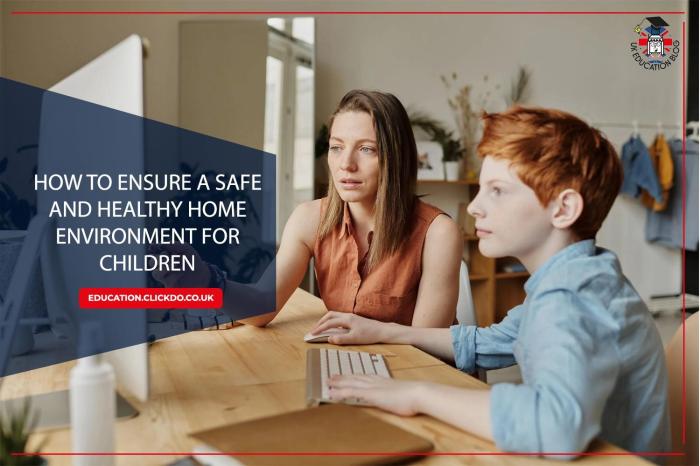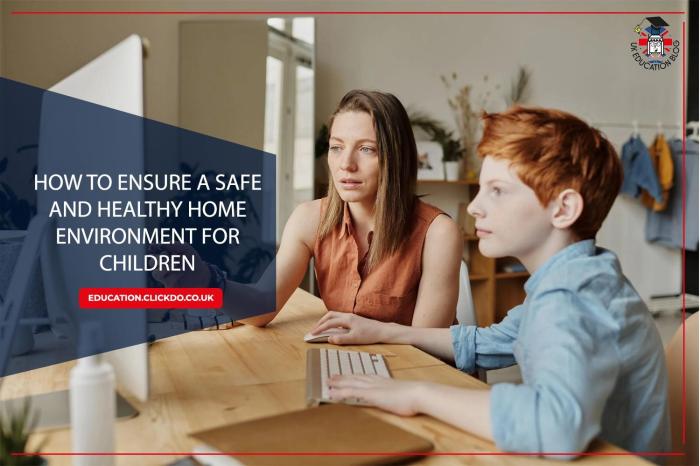How to create a healthy and safe environment for your children is a crucial aspect of parenting. It’s about more than just physical safety; it encompasses nurturing emotional well-being, providing nutritious food, fostering social growth, and instilling good hygiene habits. This comprehensive guide will walk you through practical steps to build a supportive and enriching environment where your children can thrive.
From childproofing your home to promoting healthy emotional expression, this guide covers a wide range of essential topics. We’ll explore everything from creating a stimulating learning environment to managing screen time effectively, ensuring your child’s development is supported in all aspects of their life. Discover practical tips and strategies to help you create a nurturing and safe haven for your little ones.
Physical Safety
Creating a safe environment for children involves proactive measures to prevent accidents and mitigate potential dangers. A thorough understanding of potential hazards and appropriate safety precautions is crucial for protecting children’s well-being. This includes both internal and external risks, from everyday household items to traffic and wandering.
Preventing Accidents in a Home Environment
Home environments, while loving and nurturing, can present hidden dangers if not carefully considered. Implementing childproofing measures can significantly reduce the risk of accidents. This involves identifying and addressing potential hazards in all areas of the home.
- Electrical Outlets: Covering electrical outlets is a fundamental safety measure. Outlet covers prevent accidental contact with electrical components, significantly reducing the risk of electrocution. This is especially important for young children who may be curious about exploring their surroundings.
- Furniture and Objects: Secure heavy furniture, such as bookshelves or dressers, to prevent them from tipping over. This is particularly crucial for young children who may try to climb on or around furniture.
- Windows and Balconies: Install safety devices on windows and balconies, including window guards and screens. This is critical to prevent falls, especially from high levels.
- Chemicals and Medications: Keep cleaning supplies, medications, and other potentially hazardous substances in locked cabinets or areas inaccessible to children. Proper storage prevents accidental ingestion and potential harm.
Child-Proof Modifications for Common Household Hazards, How to create a healthy and safe environment for your children
Implementing child-proof modifications for common household hazards can transform a potentially dangerous environment into a safe space. These modifications are key to protecting children from injury.
- Doors and Cabinets: Install safety latches on doors to cabinets containing potentially hazardous items. These latches can be easily adjusted to fit the child’s size and prevent access to dangerous areas.
- Kitchen Appliances: Use safety interlocks on ovens and stovetops to prevent unintentional activation. This will prevent injuries caused by improper use.
- Cleaning Supplies: Store cleaning supplies in locked cabinets or designated areas away from children’s reach. This precaution reduces the risk of accidental ingestion or misuse.
Securing the Home Against External Dangers
External dangers such as traffic and wandering present a significant risk to children. Proper precautions and monitoring are essential to minimize these hazards.
- Traffic Safety: Install visible and well-maintained fencing around the property to deter children from venturing into the street. Ensure adequate lighting to enhance visibility and improve the security of the area. Consider installing security cameras to monitor the area.
- Wandering Prevention: Ensure all exterior doors and windows are locked and secure. Establish clear boundaries and communicate expectations to children about staying within the property. This prevents children from wandering off or getting lost. Make sure children know their address and phone number.
Safety Features for Different Age Groups
The appropriate safety measures vary based on the child’s age and developmental stage.
| Age Group | Safety Features |
|---|---|
| Infants (0-12 months) | Outlet covers, crib safety rails, baby gates, window guards, secured furniture, and access control to potentially hazardous materials. |
| Toddlers (1-3 years) | All infant safety measures, plus additional safety latches on cabinets, secure small objects, and supervision in areas of potential risk. |
| Preschoolers (3-5 years) | All previous safety measures, plus clear boundaries for outdoor play areas, and basic traffic safety education. |
| School-Age Children (6-12 years) | All previous safety measures, plus continued traffic safety education, and establishing rules about going outside alone. |
Essential Safety Items and Their Storage
Having essential safety items readily available can significantly reduce response time in emergencies.
- First-Aid Kit: Keep a well-stocked first-aid kit in a readily accessible location, preferably in a designated cabinet or drawer.
- Fire Extinguisher: Position fire extinguishers in strategic locations, ideally near cooking areas and exits. Ensure they are accessible and properly maintained.
- Emergency Contacts: Keep a list of emergency contacts readily available, preferably on a laminated sheet or in a designated notebook, and place it in a visible location. Include phone numbers and addresses.
Regular Safety Checks
Regular safety checks are crucial for maintaining a safe environment for children.
- Daily Checks: Perform daily checks to ensure that all safety measures are in place, and no new hazards have emerged.
- Weekly Checks: Conduct weekly checks to assess the effectiveness of safety measures, and make necessary adjustments.
- Monthly Checks: Conduct monthly checks to inspect the condition of safety equipment and ensure it is in good working order. This is particularly important for equipment like fire extinguishers, and ensure that emergency contacts are still valid.
Emotional Well-being
Nurturing a child’s emotional well-being is just as crucial as their physical safety. A supportive and nurturing environment fosters resilience, self-esteem, and the ability to navigate life’s challenges with emotional intelligence. Creating a space where children feel safe expressing their feelings, resolving conflicts constructively, and understanding their emotions is essential for their overall development.Building a strong emotional foundation allows children to develop healthy coping mechanisms, build positive relationships, and ultimately thrive.
This involves actively listening, understanding their perspectives, and providing them with the tools they need to manage their emotions effectively.
Fostering a Supportive and Nurturing Atmosphere
Creating a supportive and nurturing atmosphere is a cornerstone of a child’s emotional well-being. This environment should be characterized by consistent love, understanding, and acceptance. Children need to feel secure in their relationships with their parents and caregivers. This includes providing a predictable routine, clear expectations, and plenty of positive reinforcement.
Promoting Healthy Emotional Expression
Children need to feel safe and comfortable expressing their emotions. This involves acknowledging and validating their feelings, even if they are difficult ones. Avoid dismissing or minimizing their experiences. Instead, try to understand the underlying cause of their emotions and help them develop healthy ways to cope. This could involve talking about their feelings, using creative outlets like art or music, or practicing relaxation techniques.
Managing Conflicts and Disagreements Constructively
Disagreements and conflicts are inevitable parts of childhood. Teaching children how to manage these situations constructively is crucial. It involves active listening, understanding different perspectives, and finding mutually acceptable solutions. Role-playing scenarios can help them practice these skills. For example, having them practice negotiating solutions to disagreements or conflicts with siblings can be a valuable exercise.
Creating a safe and healthy environment for kids is crucial. It’s about fostering a space where they can thrive, learn, and grow. This often involves thoughtful routines and boundaries. But, interestingly, some of the key traits behind those routines mirror the 7 creative habits highly successful people 7 creative habits highly successful people often exhibit.
After all, organization, adaptability, and a proactive approach are essential for a child’s well-being, just as they are for navigating life’s challenges.
Open Communication and Active Listening
Open communication and active listening are essential for understanding a child’s emotional state. Actively listen to what they are saying, both verbally and nonverbally. Validate their feelings, even if you don’t agree with their actions. Create a safe space for them to express their thoughts and concerns without fear of judgment. Asking open-ended questions can help them articulate their feelings more clearly.
Identifying Signs of Stress or Anxiety in Children
Recognizing signs of stress or anxiety in children is important. Common signs include changes in appetite, sleep disturbances, irritability, withdrawal, difficulty concentrating, physical complaints, and clinginess. These signs can vary from child to child, so it’s essential to pay attention to any unusual changes in behavior. Understanding the root cause of the stress or anxiety is key.
Activities that Encourage Emotional Intelligence
Engaging in activities that encourage emotional intelligence can greatly benefit children. These activities can include:
- Reading books about emotions: Books that explore different emotions and ways to manage them can be a valuable tool.
- Playing games that involve empathy and perspective-taking: Games that require understanding different points of view and reacting appropriately can foster emotional intelligence.
- Practicing mindfulness and relaxation techniques: Mindfulness activities, such as deep breathing exercises or guided meditations, can help children regulate their emotions.
- Encouraging creative expression: Activities like art, music, or storytelling can provide outlets for emotional expression.
- Engaging in discussions about feelings: Creating opportunities to talk about feelings and emotions can help children develop emotional vocabulary and self-awareness.
Nutritional Health
Nourishing your child with a balanced diet is crucial for their growth, development, and overall well-being. A healthy diet provides the essential nutrients needed for optimal physical and cognitive function, supporting their immune system and setting the stage for a lifetime of healthy eating habits. Proper nutrition directly impacts their energy levels, mood, and ability to learn and thrive.A balanced diet encompasses a wide variety of foods from all food groups, ensuring your child receives a comprehensive range of vitamins, minerals, proteins, carbohydrates, and healthy fats.
It’s not just about what they eat, but also about how they eat and the environment surrounding mealtimes. Creating a positive and enjoyable experience is vital for fostering a healthy relationship with food.
Importance of Balanced Diets
Balanced diets are fundamental for children’s growth and development. They provide the building blocks for strong bones, muscles, and healthy organs. Nutrients like calcium, vitamin D, and protein are essential for bone development, while iron is crucial for red blood cell production. Proper nutrition also supports brain development, impacting cognitive function, learning abilities, and overall academic performance.
Children who consume a balanced diet are typically more energetic and have a stronger immune system, reducing their susceptibility to illnesses.
Creating a safe and healthy environment for kids is crucial. It’s about fostering a sense of belonging and security, which often involves understanding their unique experiences. This can sometimes mirror the complexities of navigating different cultures, like what’s explored in the fascinating list of “25 things only third culture kids would understand” 25 things only third culture kids would understand.
Ultimately, creating a supportive space where children feel comfortable and secure is key to their overall well-being.
Nutritious Foods for Different Age Groups
Infants require specific nutrients for rapid growth and development. Breast milk or appropriate formula provides the essential nutrients in a readily absorbable form. As children grow, they need an increasing variety of foods to meet their nutritional needs. Fruits, vegetables, whole grains, lean proteins, and healthy fats should be incorporated into their diet. For example, toddlers can benefit from iron-rich foods like red meat, beans, and leafy greens.
School-aged children need a variety of nutrient-dense foods to support their physical and cognitive development, along with energy for physical activity. Older children and adolescents need sufficient nutrients for puberty and maintaining a healthy weight.
Healthy Snack Options for Kids
Healthy snacks are vital for maintaining energy levels between meals. They provide essential nutrients and prevent overeating at mealtimes. A variety of snacks from different food groups is crucial.
| Snack Category | Examples | Benefits |
|---|---|---|
| Fruits and Vegetables | Apples, bananas, carrots, cucumber, berries | High in vitamins, minerals, and fiber; promotes healthy digestion. |
| Whole Grains | Whole-wheat crackers, popcorn, whole-grain bread | Provides complex carbohydrates for sustained energy; promotes healthy digestion. |
| Dairy and Alternatives | Greek yogurt, string cheese, milk | Excellent source of calcium and protein for strong bones and muscles. |
| Protein Sources | Hard-boiled eggs, nuts, seeds, hummus | Provides essential amino acids for building and repairing tissues. |
Limiting Processed Foods and Sugary Drinks
Processed foods and sugary drinks often lack essential nutrients and are high in added sugar, unhealthy fats, and sodium. These foods can contribute to weight gain, dental problems, and other health issues. Limiting these items and opting for whole, unprocessed foods is critical for a child’s well-being. Sugary drinks, in particular, are often high in empty calories and contribute significantly to weight gain and potential health problems.
Establishing Healthy Eating Habits
Establishing healthy eating habits early on is paramount. Children learn by observing their parents and caregivers. Involving them in meal preparation and encouraging a variety of food choices is beneficial. It’s crucial to establish a positive mealtime environment, avoiding distractions and ensuring they eat slowly and mindfully. Creating a routine around meals and snacks, as well as offering healthy alternatives to less healthy options, can significantly contribute to fostering good eating habits.
Creating an Appealing and Encouraging Mealtime Environment
Mealtimes should be a positive and enjoyable experience for children. A pleasant atmosphere, including a nicely set table and engaging conversation, can encourage them to try new foods. Avoid pressure or coercion, instead fostering a sense of exploration and curiosity about different foods. Involve them in the meal preparation process, letting them choose from healthy options and help in simple tasks.
Making meals fun and interactive can establish a positive association with food and encourage healthy eating habits.
Social and Educational Environment: How To Create A Healthy And Safe Environment For Your Children
Nurturing a child’s social and educational environment is as crucial as providing for their physical and emotional well-being. A supportive and stimulating environment fosters healthy development, equipping children with essential social skills and a love for learning. This environment allows them to explore their potential and build a strong foundation for future success.A child’s social interactions shape their understanding of the world and their place in it.
These interactions provide opportunities for learning empathy, cooperation, and conflict resolution. By fostering a positive social environment, parents and educators lay the groundwork for children to develop strong interpersonal skills, crucial for navigating relationships throughout their lives.
Role of Social Interaction in Development
Social interaction is fundamental to a child’s cognitive, emotional, and social growth. Through interactions with peers and adults, children learn to communicate, negotiate, and understand different perspectives. These interactions are vital for developing empathy, cooperation, and conflict resolution skills, which are essential for navigating social situations throughout life. Observing and imitating others are also key components of learning and development.
Activities to Encourage Social Interaction and Teamwork
Creating opportunities for social interaction is key. These activities help children learn valuable skills, such as communication, compromise, and cooperation. Playdates, group activities, and family game nights are excellent ways to foster social interaction. Encouraging children to participate in team sports or collaborative art projects fosters teamwork and communication skills.
- Playdates: Scheduling playdates with other children allows them to interact in a safe and controlled environment, fostering friendships and cooperation.
- Group Activities: Organizing group activities, like story time sessions, craft workshops, or nature walks, provides a platform for social interaction and shared experiences.
- Team Sports: Engaging in team sports, like soccer or basketball, promotes teamwork, cooperation, and sportsmanship.
- Collaborative Art Projects: Activities like building a model together or creating a collaborative mural encourage children to work together, share ideas, and learn to respect different perspectives.
Creating a Stimulating Learning Environment
A stimulating learning environment fosters a child’s natural curiosity and love of learning. This environment should be adaptable and dynamic, accommodating diverse learning styles and interests. A well-organized space with a variety of materials, resources, and activities is essential for a stimulating learning environment.
- Well-Organized Space: A designated space for learning should be organized and easily accessible, with clear storage solutions for materials. This creates a structured and comforting learning environment.
- Variety of Materials and Resources: Providing diverse learning materials, such as books, art supplies, puzzles, and building blocks, caters to various learning styles and interests.
- Open-Ended Activities: Activities that encourage exploration and experimentation, such as building with blocks or playing with playdough, stimulate creativity and problem-solving skills.
Importance of Play in Child Development
Play is crucial for a child’s cognitive, social, and emotional development. Through play, children learn to solve problems, make decisions, and explore their creativity. Play also allows them to express themselves and develop a sense of self-confidence. It is essential for a healthy and happy childhood.
- Cognitive Development: Play enhances cognitive skills by encouraging exploration, problem-solving, and decision-making.
- Social Development: Play fosters social skills by providing opportunities for children to interact with others, share, and cooperate.
- Emotional Development: Play allows children to express their emotions, develop self-confidence, and manage stress.
Age-Appropriate Educational Resources and Activities
Age-appropriate educational resources and activities are vital for fostering a child’s development. These resources should align with the child’s developmental stage and interests.
- Preschool: Age-appropriate books, puzzles, and play-based activities that encourage early literacy and numeracy skills are beneficial.
- Elementary School: Engaging in hands-on learning activities, field trips, and interactive learning tools can enhance the learning experience.
Resources to Support Children’s Learning
Numerous resources can support a child’s learning at home and in the community. These resources include libraries, museums, community centers, and online learning platforms.
- Libraries: Libraries offer a wide array of books, educational materials, and programs for children of all ages.
- Museums: Museums provide interactive exhibits and educational programs that enhance learning through hands-on experiences.
- Community Centers: Community centers often host workshops, classes, and activities tailored to children’s needs.
- Online Learning Platforms: Online platforms offer educational games, videos, and resources that supplement learning at home.
Hygiene and Personal Care

Maintaining a healthy and safe environment for children extends beyond physical space; it encompasses personal hygiene. Consistent hygiene practices are crucial for preventing the spread of illness and fostering a sense of self-respect and well-being. This includes not only cleanliness but also teaching children about personal space and boundaries. Regular check-ups with healthcare professionals are equally important to ensure overall health.
Importance of Regular Hygiene Practices
Regular hygiene practices are essential for preventing the spread of germs and illnesses. Cleanliness helps maintain a healthy body and mind, reducing the risk of infections and promoting a sense of well-being. Proper hygiene habits, when established early, become ingrained routines, making it easier for children to maintain good health throughout their lives. These habits also teach children self-reliance and responsibility.
Essential Hygiene Products and Their Appropriate Use
A well-stocked hygiene kit provides the necessary tools for effective hygiene. Soap, especially antibacterial varieties, are vital for handwashing. Toothbrushes, toothpaste, and mouthwash are crucial for oral hygiene. Shampoo, conditioner, and body wash maintain cleanliness and hygiene. Choosing age-appropriate products and demonstrating proper usage are vital.
For example, children under a certain age may require special formulations of toothpaste.
Creating a healthy and safe environment for kids involves so much more than just physical safety. It’s about fostering trust and open communication, which directly connects to understanding the 7 crucial things you need honest about, like your own anxieties and vulnerabilities. 7 crucial things you need honest about can deeply influence how you approach parenting and ultimately, create a more supportive atmosphere for your children.
Recognizing these areas will help you build a stronger, safer foundation for your little ones.
Hygiene Routines for Different Age Groups
Establishing age-appropriate hygiene routines helps children develop independence and healthy habits.
| Age Group | Key Hygiene Practices | Specific Considerations |
|---|---|---|
| Infants (0-12 months) | Gentle handwashing, diaper changes, and basic oral care. | Parents should supervise and assist with hygiene routines. |
| Toddlers (1-3 years) | Supervised handwashing, toothbrushing (with assistance), and basic bath time. | Introduce age-appropriate tools and encourage participation. |
| Preschoolers (3-5 years) | Independent handwashing, toothbrushing (with supervision), and showering. | Encourage responsibility and praise effort. |
| School-age children (6-12 years) | Independent hygiene practices, including brushing teeth, showering, and maintaining personal cleanliness. | Provide guidance and support for proper technique. |
| Teenagers (13-18 years) | Maintaining personal hygiene habits and understanding the importance of skincare and grooming. | Encourage self-care and responsible habits. |
Teaching Children About Personal Space and Boundaries
Children need to understand and respect personal space and boundaries. Explaining the concept of personal space and when it’s appropriate to touch or be touched helps them develop healthy social interactions. Teaching them to respect others’ limits is vital for their emotional development.
Promoting Healthy Habits Related to Hygiene and Grooming
Making hygiene enjoyable is key to encouraging good habits. Involving children in choosing their hygiene products or creating a fun routine can make the process more positive. Positive reinforcement and praise for effort and accomplishment are vital. For example, a reward chart for consistently practicing good hygiene can be motivating.
Importance of Regular Check-ups with Healthcare Professionals
Regular check-ups with healthcare professionals are essential for maintaining children’s overall health and well-being. These check-ups allow for early detection of potential health issues and provide opportunities for preventative care. Professional guidance on hygiene and health is also invaluable.
Digital Safety and Media Consumption

Navigating the digital world is now an essential part of childhood. However, with this access comes a unique set of challenges regarding safety and well-being. It’s crucial to equip children with the knowledge and tools to thrive in this environment, fostering healthy habits and responsible digital citizenship.Digital media is a powerful tool for learning, connection, and entertainment. But unchecked screen time can negatively impact physical health, sleep patterns, and even emotional development.
A balanced approach that prioritizes responsible use and critical thinking is vital for children’s overall well-being.
Managing Screen Time and Digital Usage
Limiting screen time is essential for healthy development. Studies show a correlation between excessive screen time and attention span issues, sleep disturbances, and potential eye strain. Establishing clear guidelines and consistent routines for digital usage can significantly contribute to a healthier lifestyle. A flexible approach that adapts to individual needs and developmental stages is often more effective than strict, inflexible rules.
Age-Appropriate Digital Content and Platforms
Children’s exposure to digital content should be carefully considered. Younger children benefit from age-appropriate educational apps and games that promote learning and development in a safe environment. As children grow, their access to more complex platforms and content can be gradually expanded, but always with parental guidance and supervision. Platforms designed for specific age groups often offer features and content tailored to promote learning and interaction in a positive and safe manner.
Privacy and Online Safety
Protecting children’s privacy online is paramount. Sharing personal information online can pose significant risks. Teaching children about the importance of safeguarding personal details, like names, addresses, and photos, is critical. Children need to understand that not everyone online is who they seem to be and that information shared online can potentially be accessed by others.
Teaching Responsible Online Behavior
Teaching children about responsible online behavior is essential for fostering digital citizenship. This involves instructing them about respecting others’ opinions, refraining from cyberbullying, and understanding the consequences of their online actions. A proactive approach, rather than a reactive one, is crucial for effectively instilling these values. Open communication and clear guidelines can foster a sense of accountability and responsible digital conduct.
Strategies for Teaching Children About Responsible Online Behavior
Open and honest conversations are key to fostering a safe online environment. Regular discussions about online etiquette, responsible use, and the potential risks associated with sharing information are crucial. Modeling appropriate online behavior is vital; children often learn by observing their parents and caregivers. Encouraging critical thinking about online content and interactions is another important strategy. Parental involvement and consistent communication are essential for guiding children through the complexities of the digital world.
Comparing Digital Safety Tools and Platforms
| Tool/Platform | Features | Target Age Group | Pros | Cons |
|---|---|---|---|---|
| Common Sense Media | Provides ratings and reviews of digital content, helping parents make informed decisions about what their children watch and play. | Families with children of all ages | Offers detailed information, age-appropriateness guidelines, and filters. | Can be overwhelming to navigate. |
| Google Family Link | Allows parents to set limits on screen time, manage app usage, and monitor online activity. | Children of various ages | Provides comprehensive parental controls. | Requires some technical proficiency to set up and manage. |
| Screen Time Apps | Designed to track and manage screen time for children. | Families with children of various ages | Helps with establishing consistent screen time limits. | May not address the complexities of online safety. |
Open Dialogue About Digital Media
Open and honest communication about digital media is essential. Families should create a safe space where children feel comfortable discussing their online experiences, concerns, and questions. This dialogue helps build trust and allows parents to address potential issues promptly. It also helps children develop critical thinking skills regarding the information they encounter online.
Outdoor Activities and Play
Outdoor play is essential for a child’s healthy development, fostering physical, cognitive, and social skills. It provides opportunities for exploration, creativity, and interaction with the environment, building resilience and independence. A well-structured outdoor play area can significantly contribute to a child’s overall well-being.Outdoor play is crucial for children’s development, allowing them to burn energy, build strength, and improve coordination.
It provides a platform for learning about the natural world, enhancing problem-solving abilities, and developing crucial social skills through interaction with peers. A child’s outdoor experience shapes their understanding of the world around them.
Safe Outdoor Play Activities for Different Age Groups
Children at different developmental stages require tailored play activities. Infants and toddlers benefit from simple sensory exploration, such as discovering textures and colors in the garden or playing with water and sand. Preschoolers thrive on imaginative play, like creating forts in the backyard or engaging in role-playing scenarios. School-aged children can participate in more complex activities, such as team sports, building elaborate structures, or exploring nature trails.
These activities promote both physical and mental growth.
Creating a Safe Outdoor Play Area
A safe outdoor play area prioritizes children’s well-being. It should be free of hazards like sharp objects, loose gravel, or exposed electrical wires. Clear boundaries and designated areas for different activities can help prevent accidents. Adequate supervision is essential, especially for younger children. Natural elements, like trees, rocks, and water features, can be incorporated to enhance the play experience and encourage exploration.
Encouraging Exploration and Discovery
Encouraging exploration and discovery is key to a child’s development. Allow children to choose their own activities, discover hidden places, and create their own games. This fosters creativity, problem-solving skills, and a love for learning. Avoid overly structured play environments, allowing for spontaneous interactions with nature. Providing resources like magnifying glasses, nature journals, and binoculars can further stimulate exploration and encourage a deeper understanding of the natural world.
Benefits of Spending Time in Nature
Spending time in nature offers numerous benefits for a child’s development. Exposure to natural elements promotes physical activity, improves concentration, and reduces stress. Children who spend time outdoors tend to develop a stronger connection with the environment and a greater appreciation for nature’s beauty. Outdoor experiences can foster creativity, imagination, and a sense of wonder. Studies show that spending time in nature positively impacts children’s emotional regulation and overall well-being.
Resources for Outdoor Play and Recreation
- Local parks and playgrounds offer diverse play spaces and equipment for different age groups.
- Community gardens and nature centers provide opportunities for hands-on learning about plants, animals, and ecosystems.
- Hiking trails and nature reserves allow children to explore the outdoors and develop an appreciation for nature.
- Libraries and community centers often host outdoor events and programs designed for children and families.
- Local sports organizations and recreation centers provide facilities and opportunities for team sports and other physical activities.
Concluding Remarks
Ultimately, creating a healthy and safe environment for your children is a journey of continuous learning and adaptation. By prioritizing physical safety, emotional well-being, nutritional health, social and educational development, hygiene, digital safety, and outdoor activities, you’re empowering your children to grow into well-rounded individuals. Remember that every child is unique, and what works for one might not work for another.
Be flexible, observant, and always prioritize open communication to tailor your approach to your child’s specific needs.











